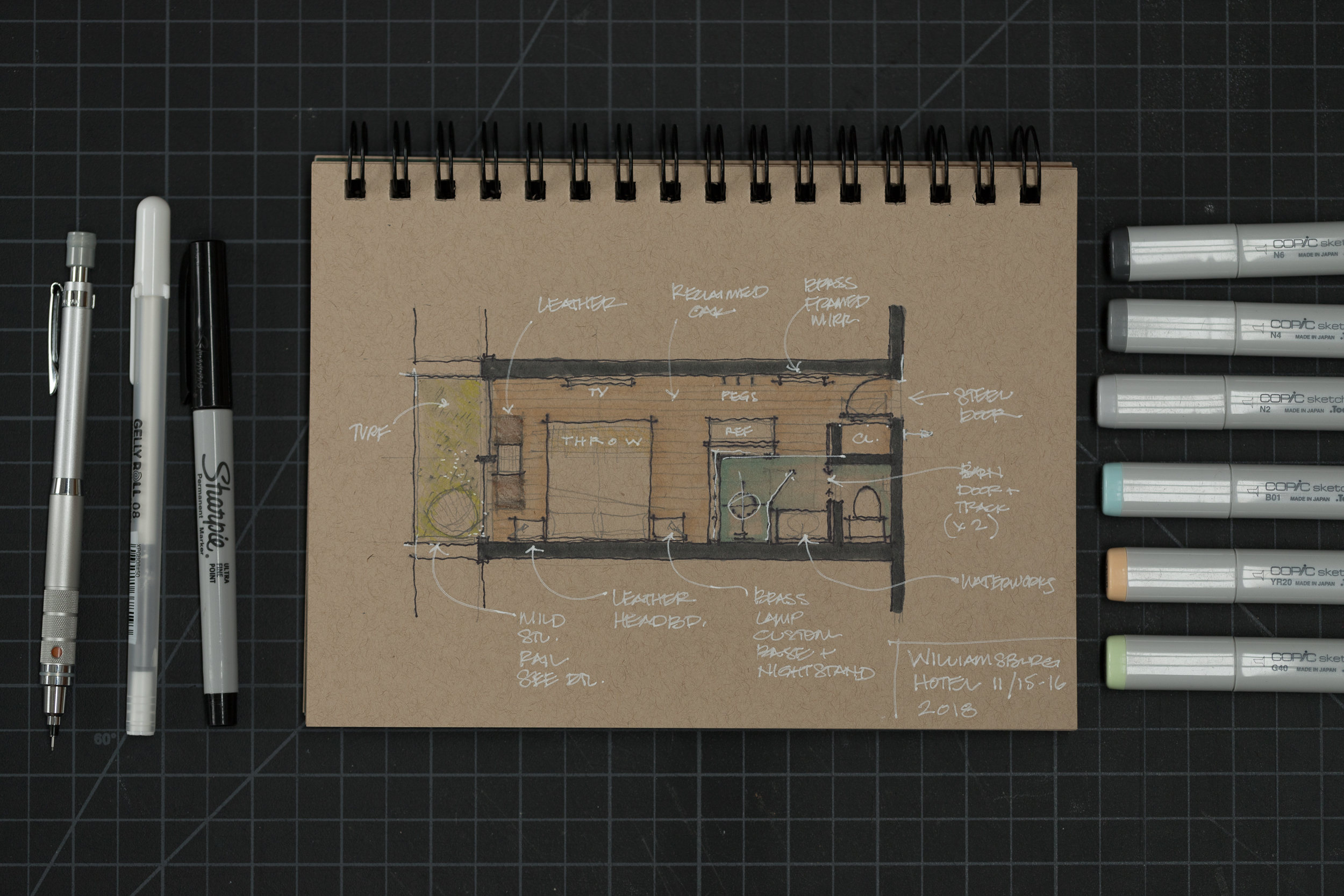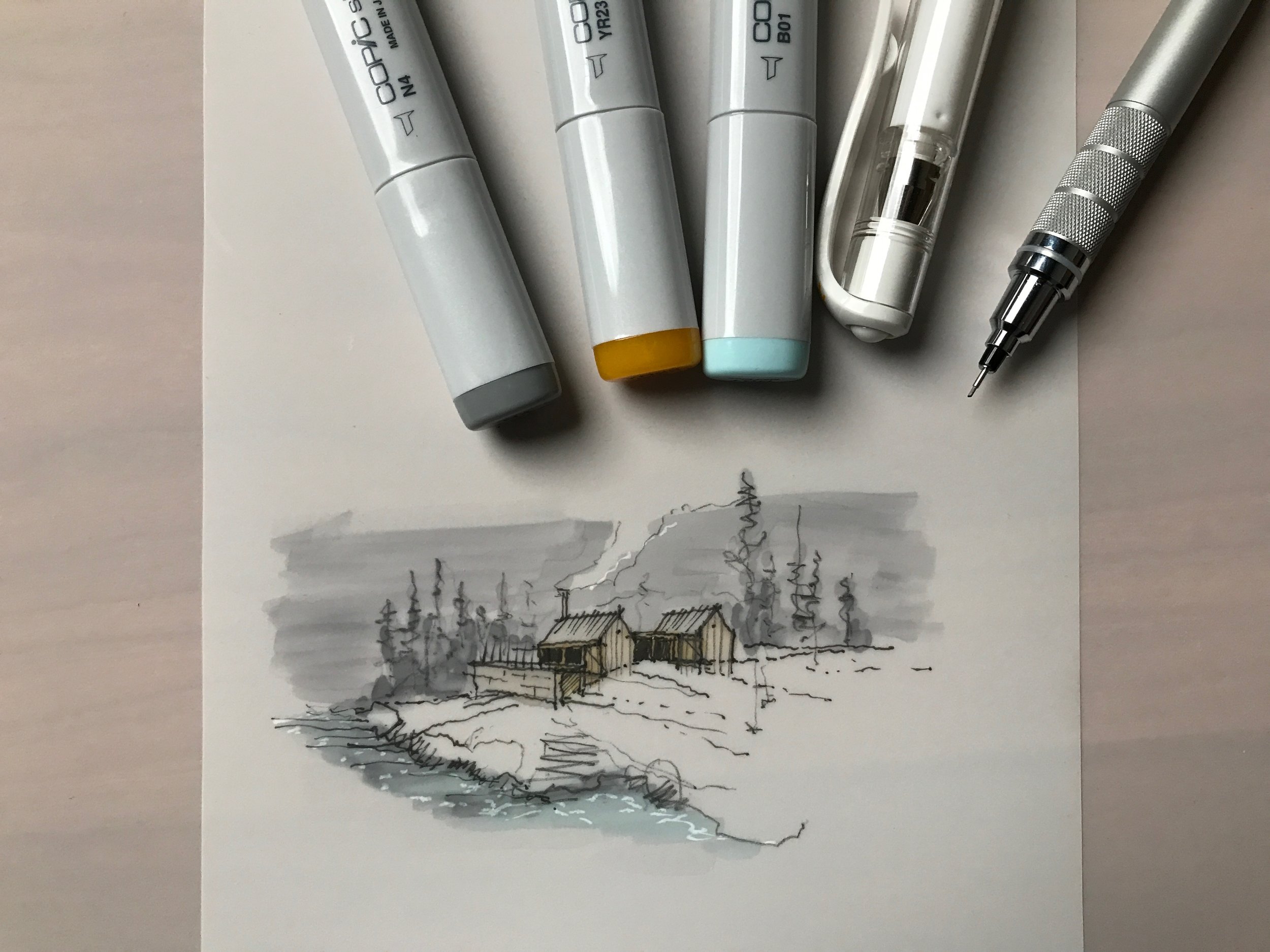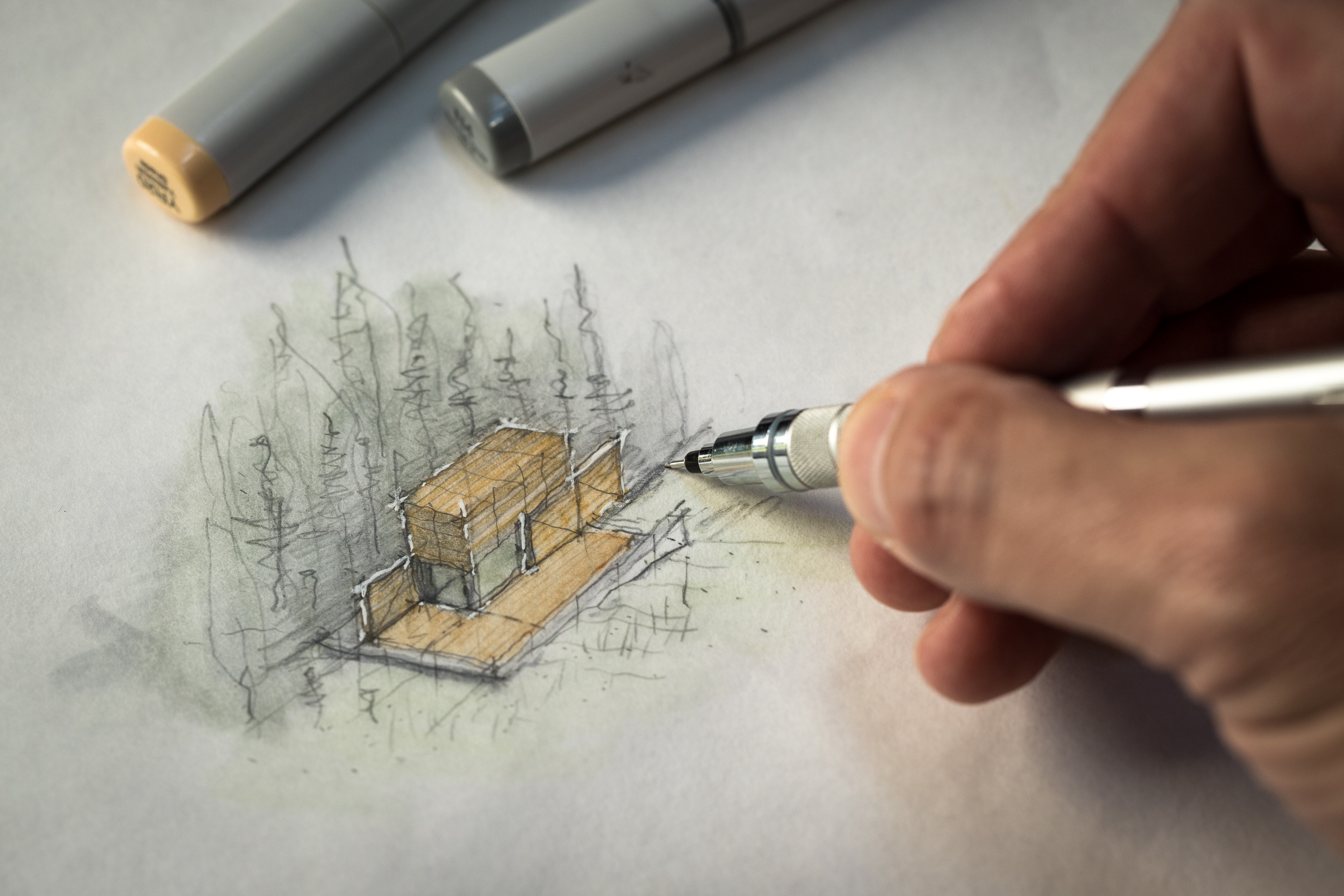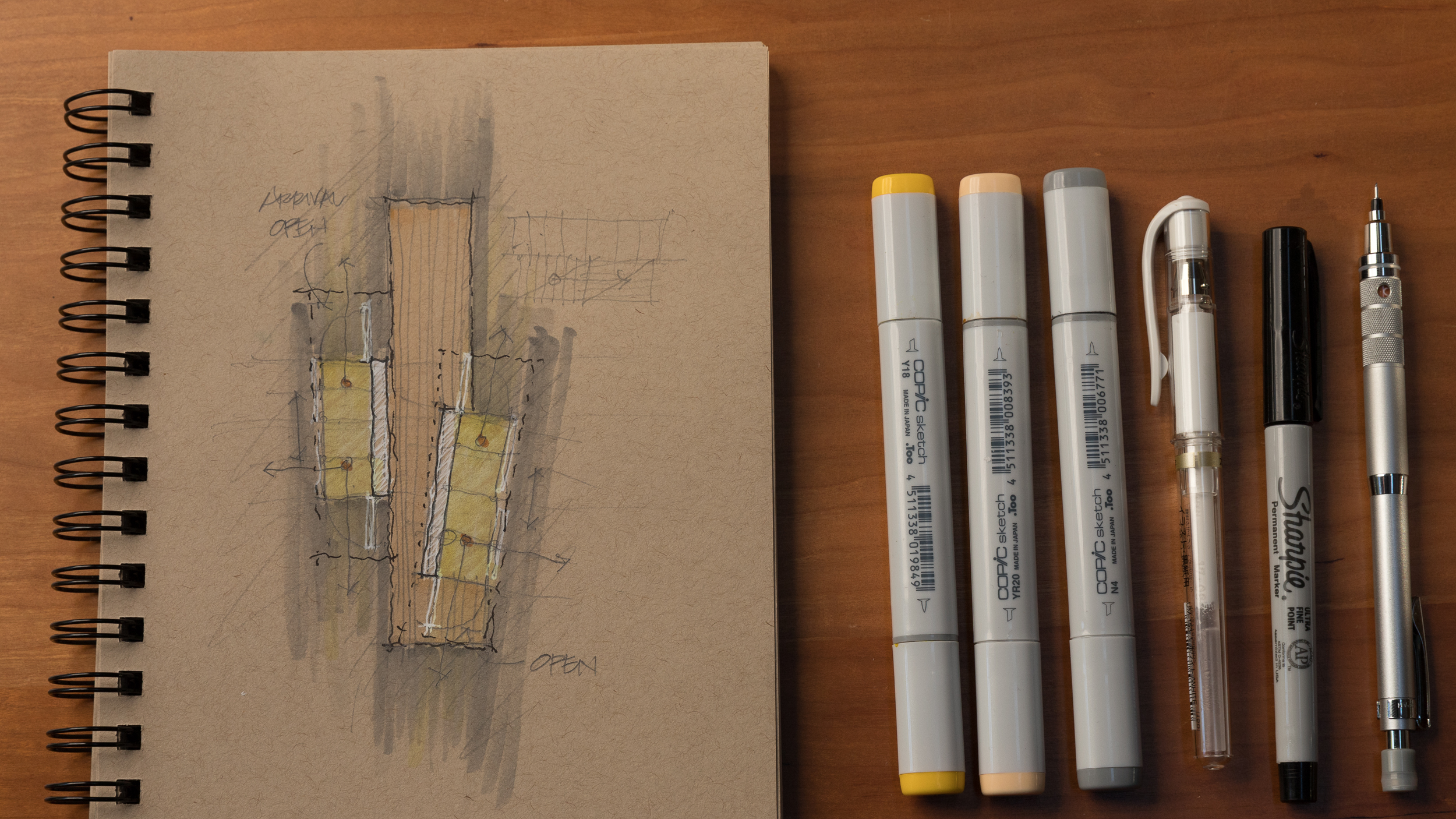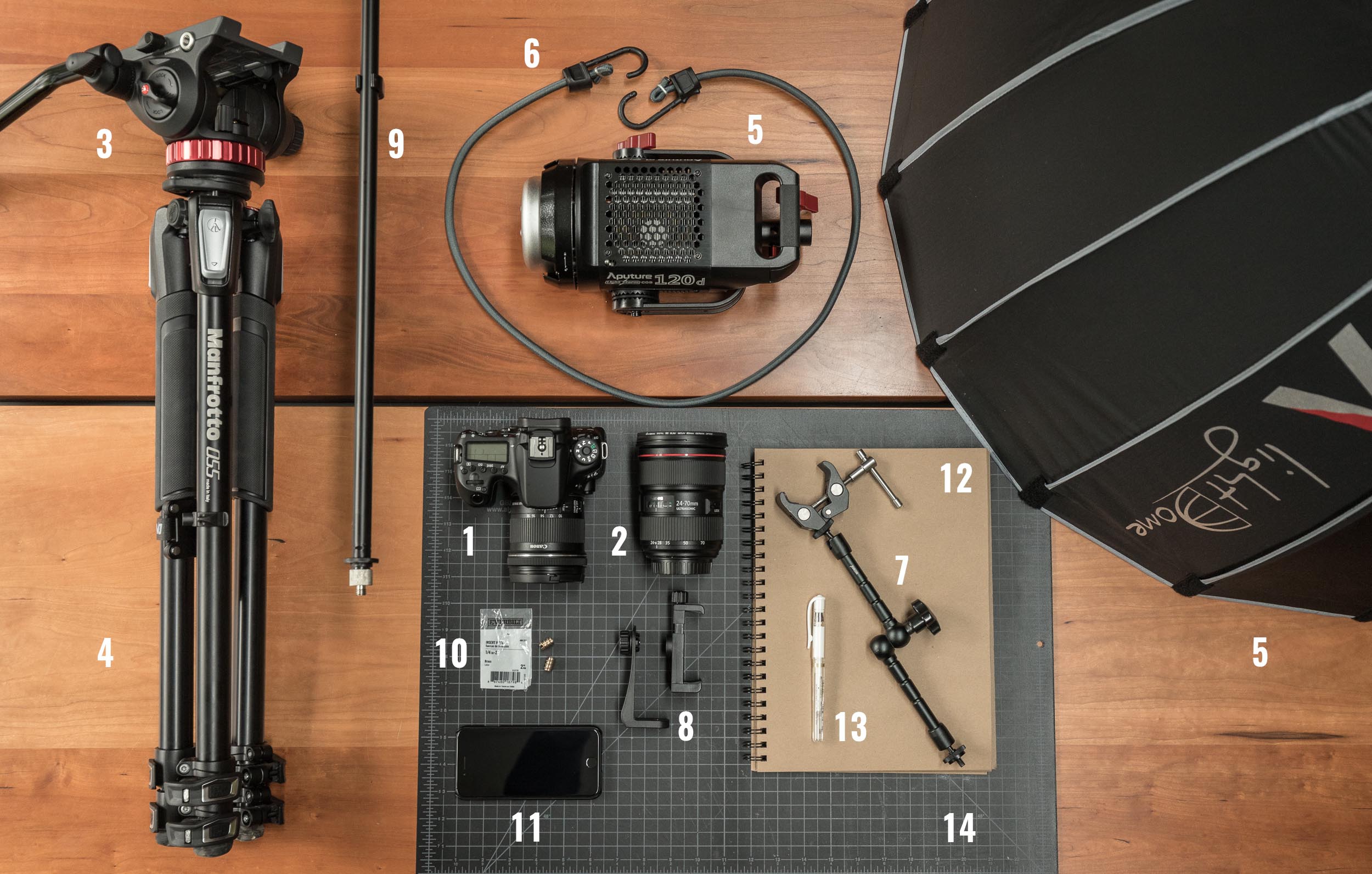Stacking up 50+ layers of cork to create a site model for our new residential project: The Outpost located on a remote island off the coast of Maine
Read MoreArchitecture, Design + Photography (podcast interview with Trent Bell)
A conversation between two architecture school graduates with similar approaches to work + life who followed two very different paths. This video is an excerpt from my conversation with Trent Bell an award-winning architectural photographer (Trent Bell Photography) as we chat in my studio. You'll also join us behind the scenes as he photographs one of my residential projects. For the full interview be sure to check out Trent’s Architecture, Design & Photography podcast, (video here) a project he’s launched in cooperation with Maine Home + Design magazine. See all the photos we captured that day here.
Gear used during the photo shoot:
Light stand
White Lightning 3200 (X-series) Strobe - Paul C. Buff
An Incredible Resource for Architectural Inspiration
With more than 581,000+ architectural drawings, photos, and documents to download and use as you please, I couldn't keep this incredible resource to myself any longer. The HABS (Historical American Buildings Survey) along with HAER (engineering), and HALS (landscape) are a collection of building surveys from the American architectural, engineering, building and landscape culture maintained by the Library of Congress in Washington, DC. In this video, you’ll peek in the collection and see how I use it in my architecture practice.
The program was born in the 1930's during the Great Depression as a means to put unemployed architects to work with a mission to preserve and document the architectural heritage of America. Since then, the archive has catalogued more than 43,000 individual structures and more are added each year.
I use it for: creative inspiration, precedent research, to improve my architectural drawing, graphics and delineation techniques, and to study details from some of America's most famous works of architecture.
If you enjoy these videos, you can support 30X40’s work on YouTube by investing in a course, a toolkit or a digital tool. Many thanks!
Architectural Model Making Tips
Architects build two fundamentally different types of models: presentation models and study models. Presentation models are often used in client meetings to convey a finished design in miniature while study models are used by architects as part of the design process. Study models are the equivalent of a three-dimensional sketch and allow us to explore and iterate design ideas quickly. We often begin these by collaging ideas using planes of cardboard and wood.
In this video, I share my best tips for building architectural models something I’ve done professionally for close to 30 years.
Building models remains an important tool and part of my personal process for making architecture. And while many have moved to completely digital forms of modeling, I’ve maintained the habit of building models. Here’s why: there’s a sensory feedback loop between the hands and the brain known as embodied cognition. It’s been shown that our motor system influences our understanding and cognition in much the same way the mind can influence our physical actions. I build models to unlock creative inspiration I can’t otherwise access (they’re also pretty fun to build).
tools + materials key:
Chipboard .05” thick + .03” thick
Corrugated cardboard
Sanding block
Guitar strings (wire accents)
Flat nose pliers (bending wire)
White glue (I prefer Elmer’s)
Self-healing Cutting mats (12”x18” + 18”x24”, taped together)
Making Architecture Models (a tutorial)
I've always found satisfaction in turning scraps of wood and cardboard into a tiny model, but I haven't always loved the finished product. If you've struggled with this too (or if you’re just curious about model making) you'll appreciate this week's video where I share my model making techniques.
I'll show you the materials I chose, why I chose them and a few - less expensive - alternatives. I discuss why you would choose one modeling style over another, how to conceptualize what to model and how a few simple tweaks can make a big difference in the esthetics of your architectural models.
If you enjoy these videos, you can support 30X40’s work on YouTube by investing in a course, a toolkit or a digital tool. Many thanks!
How to Write Like an Architect
Learn how to write like an architect
Read MoreNOW
I’ve been wanting to make a “Now” page for a while and I’m posting here to introduce it. A “Now” page is just a collector…a place to post all the things that are inspiring my work + thinking in the studio right “Now”. My Instagram page used to be the place to do that, but fighting with an algorithm took some of the fun out of it for me. I found I wasn’t posting some of the pictures and work that I really wanted to…like the one below for example. I hope you’ll head over there to check it out (and maybe start your own).
Studio Joy Works : Architectural Monograph Review
Studio Joy Works, an architectural book review
Read MoreA Gift in the Making
Sharing a side project of mine and a holiday tradition I have in the studio. Side projects - for me - are a reminder that my entire creative life isn’t wrapped up in a singular project, rather who I become as a designer, as a person, is the result of a long winding path as I travel from one idea to the next. I’ve found it liberating to slip between definitions of what I am professionally. I’m an architect, yes, but I’m also a typographer and a filmmaker, a paper cutter, a UX designer, a writer and a photographer.
And this is why I love side projects so much, they allow me to be any or all of these things. There’s no pressure to perform or even to share the results, the lessons can be all mine. As the creative director, I set the constraints, the budget, and the schedule.
Your side project may be as simple as making a holiday card or it could be as life-changing as my YouTube channel has been for me. That too started as a side project. Side projects add dimension to your creative life and at some point you may discover that your side project has transformed into your main project. This jockeying for attention amongst opportunities means you’re always left with fulfilling, interesting, engaging projects to take on each week.
Materials List *:
Letterpress plates - custom designed by 30X40 (Eric) + fabricated by Boxcar Press
Gray Cardstock
Cedar Shavings
Red embroidery thread
Guitar String (18 gauge nickel)
Letterpress machine (the original machine you see in the video is no longer available, the link brings you to the cassette which I really like and would work with many machines available on the market today.
Scissors (new favorite)
Cheers my friends…wishing you happy holidays and a prosperous 2019…!
Travel Habits of an Architect
I’ve been doing a lot of traveling lately so in this video, I wanted to share some of my architect travel habits for sketching and photography. These tips apply even if you’re not an aspiring architect and will help you wring the most out of any trip you take, near or far. (And, be sure to stick around at 4:46...wait for it...)
GEAR
My travel kit is as lean as it’s ever been, just a sketchbook, a few drawing tools, my camera gear (more details here) and a small laptop. You don’t need an expensive camera or special tools though to do what I do. The DSLR is an intentional choice for me as it forces me to slow down when I'm traveling. It makes me think about lens selection and composition, the subject, the lighting. It’s probably the single best investment I’ve made in the past 10 years (aside from travel).
**MY UPDATED DAILY CARRY CAN ALWAYS BE FOUND HERE.
For lenses on this trip I brought a wide zoom, a medium zoom, a telephoto and a macro. And this was way too many. Lenses are heavy and to lug these things around in a backpack in the tropics is…well, sweaty. Of the four I brought along, I used the 24-70mm and the 100mm most of the time. The zoom is great because the 24mm end on a full frame camera is wide enough to capture landscapes or interiors and the 70mm is perfect for details. Then you have the right around 50mm is great for portraits. So this one lens covers a lot of situations.
You'll learn why I reject guidebooks in general, my process for observing, documenting and then cataloguing my travels and you'll see what I do in the downtime between destinations.
Time Stamps:
0:22 Start Now. Don’t wait until you arrive at your destination to start taking photos or sketching.
0:42 Follow 30by40 on Instagram: http://thirtybyforty.com/instagram
0:49 Travel Essentials.
1:28 My Routine (Shoot then Sketch)
1:55 Subjects. Not everything has to be architectural.
2:53 Details + Materials = Experience. Learn to observe the world this way.
4:46 Wait for it…
4:55 Has this ever happened to you? Relaxing on the beach and out of nowhere…!?
Sketchbook - 50pages from Strathmore (trying something new…I quite like it)
White pen - ink isn’t semi-transparent, but flows nicely, not gummy at all
Copic Marker Set (grays) - essential (this is a set of 5 and includes a non-smudging Multiliner pen too)
Blue + Tan + Green + Yellow Copics are from the blending trio sets (they’re cheaper to buy as sets)
Mechanical Pencil (a personal favorite)
White colored pencil (wood-free)
SIDE NOTE: The Williamsburg Hotel (at 3:16) in Brooklyn, NY was designed by the London Architecture Firm: Michaelis Boyd and completed in 2017. We actually had no plans to stay here, but we arrived in NYC to an early season snowstorm and our connecting flight back to Maine was canceled. Our flight the following day wasn’t due to leave until 10pm, so at my better half’s urging, we traveled from JFK airport to Williamsburg in Brooklyn and spent the next 24 hours exploring the neighborhood and staying in this fantastic hotel. Completely worth the little bit of extra effort to get there from JFK.
Client Meeting + Site Visit - The OUTPOST
Tag along on a client meeting and site visit to a very special location on a small island miles off the coast of Maine. Together we walk the site, sketch and discuss the strategies for building in such a pristine environment. You'll hear the questions I ask, the ensuing discussions and discover the ideas that shape the design process and ultimately our architecture. And, perhaps surprisingly, it's more than just a solving of functional problems.
This is a side of the architectural design process rarely seen and a wide-ranging discussion that questions local architecture and building traditions, how to design for experience. We cover everything from the mundane and practical to the conceptual.
Architectural Sketching (techniques + tips)
Looking for all the links to my essential sketching tools? ( Here they are )
Below you’ll find the images shown in the video along with the media and tools I used to create each.
Copic markers (link is for the neutral gray set) YR20, N2, N4, N6, G40, G94
Copic markers (link is for the neutral gray set) B01, YR23, N4
Copic markers (link is for the neutral gray set) YR20, N2, N4, N6, G40, G94
Copic markers (link is for the neutral gray set) Y18, YR20, N4
Copic markers (link is for the neutral gray set) B01, G40, YR20, N4
Inside My Sketchbook - An Architect's Essential Tools
A look inside my sketchbook as I start a new project and review my current favorite sketching tools. See my go-to paper, pens, pencils, markers; everything in my everyday carry kit for sketching.
Instead of the chronological approach I've used in the past, I now dedicate entire sketchbooks to individual projects, tasks, or idea categories. I've found this helps me to organize information and find it quickly when I'm searching for it later.
Sketchbook
BLANK Sketchbook - Custom designed + manufactured by 30X40
Pencils
Kuru Toga .5mm - I use this for sketching currently. If you prefer a chunkier lead, try this lead holder clutch made by E+M
Pens + Markers
Accessories
Modern Practice Series - Ep 2 Eponymous Architecture (cont'd)
After more than two decades of working for other architects, John decided to step out on his own. In part 2 he recounts the move from moonlighting to starting Eponymous Architecture and his early client work. He shares the difficulties he’s faced along the way, how he’s structured his life and practice, where he’s been finding new projects, and even a few unexpected advantages of going solo. This is a window into the early days of starting an architecture firm from nothing.
Topics discussed:
1:01 Testing the waters
1:59 Making the leap
3:51 The Lean Startup – Software + Hardware
5:37 Challenges of Sole Practice
8:30 Material library (in a small space)
9:47 Becoming a Better Architect
11:49 Your Portfolio (of someone else’s work)
15:21 One Year. Enough time?
17:02 Why Eponymous?
**Did you miss part 1? Here’s the link: https://youtu.be/yOAIf6WX6mY
Modern Practice Series - Ep 1 Eponymous Architecture
In this new series, I’m visiting architects and design professionals asking them to share the choices, challenges, failures, successes and failures that have shaped their careers. Too often we hear from only those architects elevated by the media to superstar status. These so-called 'starchitects' account for a small percentage of design professionals. And, the stories from the bulk of our ranks - a great many talented architects and designers – remain untold. This series gives voice to their stories.
We uncover early inspirations that led them to choose architecture, experiences in architecture school, internships, what firm typologies to look for, advice for taking the Architectural Registration Exams (ARE), how to find work and clients, working for and with others, networking and struggles building a business.
In the inaugural video of the series we meet John Clappi, a licensed architect living and working in Brooklyn, New York. He has more than 20 years’ experience practicing architecture in both Boston and New York City at a variety of scales from large developments to award winning Record Houses and private residences. He’s worked for two starchitects: Richard Meier of Richard Meier and Partners and Brad Cloepfil at Allied Works, both high-end, boutique design firms. In part 1 he recounts the school years and his early career pivot points as well as his experience working for Meier and Allied Works and time working on large scale developer projects in New York City.
In part 2, we’ll discover why he set out on his own, how he secured his first commissions and the challenges he’s facing as he builds out a larger vision for his nascent architecture studio: Eponymous Architecture, PLLC.
It’s a rare and candid look into the struggles designers and architects face as we seek to become licensed professionals and to find a life of true, creative fulfillment.
A Thank You + Unboxing the 100K Silver Play Button
Taking a moment as I received a special package from YouTube on the studio's doorstep to reflect on an important milestone. YouTube recognizes creators at a few waypoints, the first being when you cross 100K subscribers, then 1M, and then 10M. Earlier in 2018, I crossed the first of those and this video is my thank you note. Ironically, the week I received the award the channel was passing 186K subscribers.
I'm so humbled by the support and kindness you've shown as I've worked over the past five years to make better things, more interesting content, and exponentially increase the number of people I'm able to reach + connect with.
I never thought I’d get this award, it’s certainly not something I set out to achieve. To think that 100,000 people thought enough about what I had to say to subscribe is just a completely silly notion (especially when I look back at some of the things I’ve made in the past). In the beginning, I focused on sharing knowledge and documenting what I was creating. As time went on, I started to have higher expectations of my work; I became interested in filmmaking, composition, color grading, audio, and storytelling. I think I make a lot better things than I used to, but I'm nowhere near as good as my heroes or as I want to be. And, I know when I look back on this in another year’s time I’ll see what I made today wasn’t that great either.
However, without a body of work to look back on, I’d have no context to see the journey. It's important to remember that we can’t possibly make our best work the first time we publish something, it takes practice, discipline and the knowledge that most of what we make won’t live up to our own high standards. In time we get better. This was the 196th video uploaded to YouTube for me; that's a lot of practice!
I hope this inspires you to take action and to make things. See my path and take comfort in the fact that I just pressed 'publish' - even when I wasn't capable of executing at my own high standards. Pressing publish is the only way to improve. There are no more gatekeepers, if you have access to the internet and a smartphone you too can speak to millions of people if you choose.
Thank you, thank you, thank you, for allowing this kind of life to be possible and for being such an important part of my story on YouTube.
(Architecture) Conferences. Why Bother?
I used to thumb my nose at conferences, but this year something changed. I decided the island I've been living on felt a little too isolating; a little too small. And so, I thought brushing up against 26,000 other architects might be a good excuse to get out of my own head and see what everyone else in this profession was up to. I secured a press pass to attend the 2018 AIA (American Institute of Architects) national convention in New York City and I came away surprised by just how much I enjoyed it.
If you're an introvert - like me - it’s easy to avoid large groups of people, but even introverts need to network with others and to hear new ideas. I've learned time and again that whenever I'm able to step outside my comfort zone, great things happen and this experience didn't disappoint. I met viewers of this channel, students, interns, and architects from all around the world of all ages.
A few of the things I came away with:
+New ideas + inspiration
+Larger network of connections + contacts
+Deeper connection + appreciation of NYC
+Behind the scenes info. on buildings & systems
+Cutting-edge information via seminars + thought-leaders
+New product info.
+Some really amazing food
+Chance to meet & collaborate with IRL an amazing friend and mentor from down under.
Stick around to the end for details on how you can help shape the future of this channel and a chance at one of five, one-on-one chats with me, here's the link.
How I Record Overhead Sketching Videos
SETUP 1 ( $$$ )
1. Camera - Canon 70D + Canon 6DMKII
2. Lenses - Canon 24-70mm f2.8L II + Canon 16-35mm f4L
3. Tripod - Manfrotto 055
4. Video Head - Manfrotto MVH502AH
5. Light - Aputure 120D + Light Dome
6. Bungee cord x1 (or) Sandbags
SETUP 2 ( $ )
8. Phone Mount
9. Boom Stand
10. Threaded Brass Insert (1/4"-20)
11. Smartphone (by you)
12. BLANK Sketchbook
13. White Gel Pen
(Another) Day in the Life of an Architect vlog
In this installment of the vlog, look through a drawing set for a project under construction and learn how I approach and draw architectural details. I discuss one of the most common struggles of working alone, what happens when a project is delayed, how to create a balanced practice, and I share my thoughts on the innovative business plan presentations I reviewed as a juror for the architecture business plan competition.
Don't miss the view from my mid-day hike (!) and what I learned on the podcast I was listening to.
Learning to See (Like an Architect)
As architects, our job is to uncover what’s hidden...in a place, in our clients, in the materials we use. We're taught to make our discoveries visible and tangible. We're taught to give the silent a voice. To do this, we explore, analyze, consider, dissect, unearth and seek to understand the meaning of things which are often hiding in plain view. Finding a muse is one of the best tools I've discovered to teach the depth of research and skill required to become a more thoughtful designer. A muse will teach you how to truly see like an architect.
Learn more about mine here:


![Smoked Whitefish, Christmas Eve 2018 [ Photo: Eric Reinholdt, 6DMKII 100MM f2.8L ]](https://images.squarespace-cdn.com/content/v1/58b58a96f5e231aa75f48ec4/1548074005888-VGANK4WAKRD6IRHU8F3Z/whitefish-dad-2018-2.jpg)

